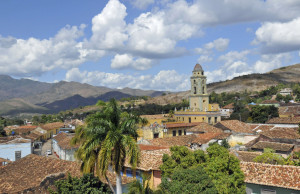With the increased availability of authorized “people to people” travel to Cuba, Americans seeking picturesque villages can find them in this hemisphere. Trinidad, Cuba, a UNESCO World Heritage Site famous for its Old World charm, also provides an opportunity to observe the practices of a mysterious New World religion.
Trinidad was founded on December 23, 1514, more than 50 years before St. Augustine, the United States’ oldest city. Trinidad became rich trading in both sugar and the slaves needed on nearby plantations. A well-preserved central square, surrounded by red-tiled mansions, reflects that golden age.
With the abolition of slavery, the trade that had supported Trinidad ended and Trinidad clocks seem to have stopped in the nineteenth century. Pastel-colored homes have open windows with only metal bars separating the room inside from the street. Donkeys pull carts down narrow cobblestone streets, pigs roast on wooden spits turned by hand and guitar players sing more for themselves than for tourists.
Slaves from western Africa carried with them the worship of gods (“orishas”)representing many aspects of their lives. Forced by Spanish masters to practice Roman Catholicism, they cleverly merged their ancestral beliefs with those of Christianity. The resulting syncretic religion is called “Santeria” (saint worship)because practitioners worshipped the statues of saints, which they had re-identified as their orishas. Many Cubans still call themselves Catholics but practice Santeria at home, some with sacred African images painted on the backs of saints.
Some of the practices of Santeria are closed to outsiders,but others are on display in Trinidad’s unique Casa Templo de Santeria Yemaya, a combination museum and house of worship. A blue and white altar pays homage to Yemaya, a goddess of the sea looking a lot like the Virgin Mary. A cigar-smoking Babalawo will, if properly motivated, explain the non-secret aspects of Santeria when not out back conducting services, including sacrifices, for believers.
